Everything You Need to Know About Platerpus
Platypus facts
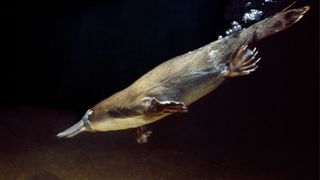
The platypus (Ornithorhynchus anatinus) is ane of the near unusual creatures in the animal kingdom. The platypus has a paddle-shaped tail, like a beaver; a sleek, furry body, like an otter; and a flat bill and webbed anxiety, like a duck. In fact, the first time a stuffed platypus was brought from Australia to Great britain, people couldn't believe it was a existent animal; they idea a trickster had sewn 2 animals together, according to London'south Natural History Museum.
Platypuses (which is the correct plural grade, not "platypi") are amid the few venomous mammals. Males take a spur, connected to a venom-secreting gland, on each hind foot. More venom is secreted during mating flavour, leading researchers to think that the spurs and venom help males compete for mates, according to the Australian Platypus Conservatory. The venom is non life-threatening to humans, but it can cause astringent swelling and excruciating hurting.
Related: Egg-laying mammals and peacock spiders: Meet some of Commonwealth of australia's weirdest creatures
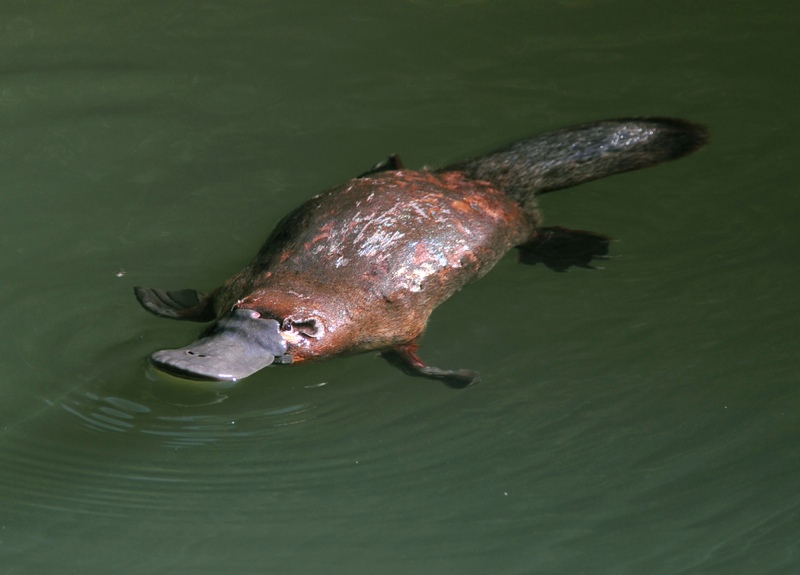
Size and appearance
Adult male platypuses tin can range between about 15.seven inches to 24.viii inches (39.8 to 62.9 centimeters) long, from the tip of the bill to tip of the tail, according to the Australian Museum. Adult females range from 14.5 to 21.six inches (36.8 to 54.8 cm) long. Developed males counterbalance about 1.7 to 6.6 lbs. (0.8 to iii kilograms) and females counterbalance about ane.3 to 3.7 lbs. (0.half-dozen to one,seven kg).
Scientists have found fossils that propose that ancient platypuses were significantly larger than the modernistic diversity, at nearly 3.3 feet (i meter) long, Live Science previously reported.
Platypuses accept dumbo, thick fur that helps them stay warm underwater. Most of the fur is dark brown, except for a patch of lighter fur near each middle and lighter-colored fur on the underside. Nether ultraviolet light, nevertheless, platypuses' drab brown fur glows green and blueish, Alive Science previously reported. It's possible that this biofluorescence helps reduce the animals' visibility to predators, but the eerie glow may serve picayune or no ecological function. Scientists are even so investigating this question.
A platypus's front anxiety take extra skin that acts like a paddle when the animal is swimming. When platypuses are on land, their webbing retracts, making the claws more pronounced, co-ordinate to National Geographic. The animals walk on their knuckles to protect the webbing, according to a 2001 report in the Journal of Experimental Biology.
The bill of a platypus resembles that of a duck and has a polish texture that feels like suede. It is likewise flexible and rubbery. The skin of the beak holds tens of thousands of sensory receptors that help the platypus navigate underwater and notice move of potential food, such every bit shrimp, according to the Australian Platypus Conservatory.
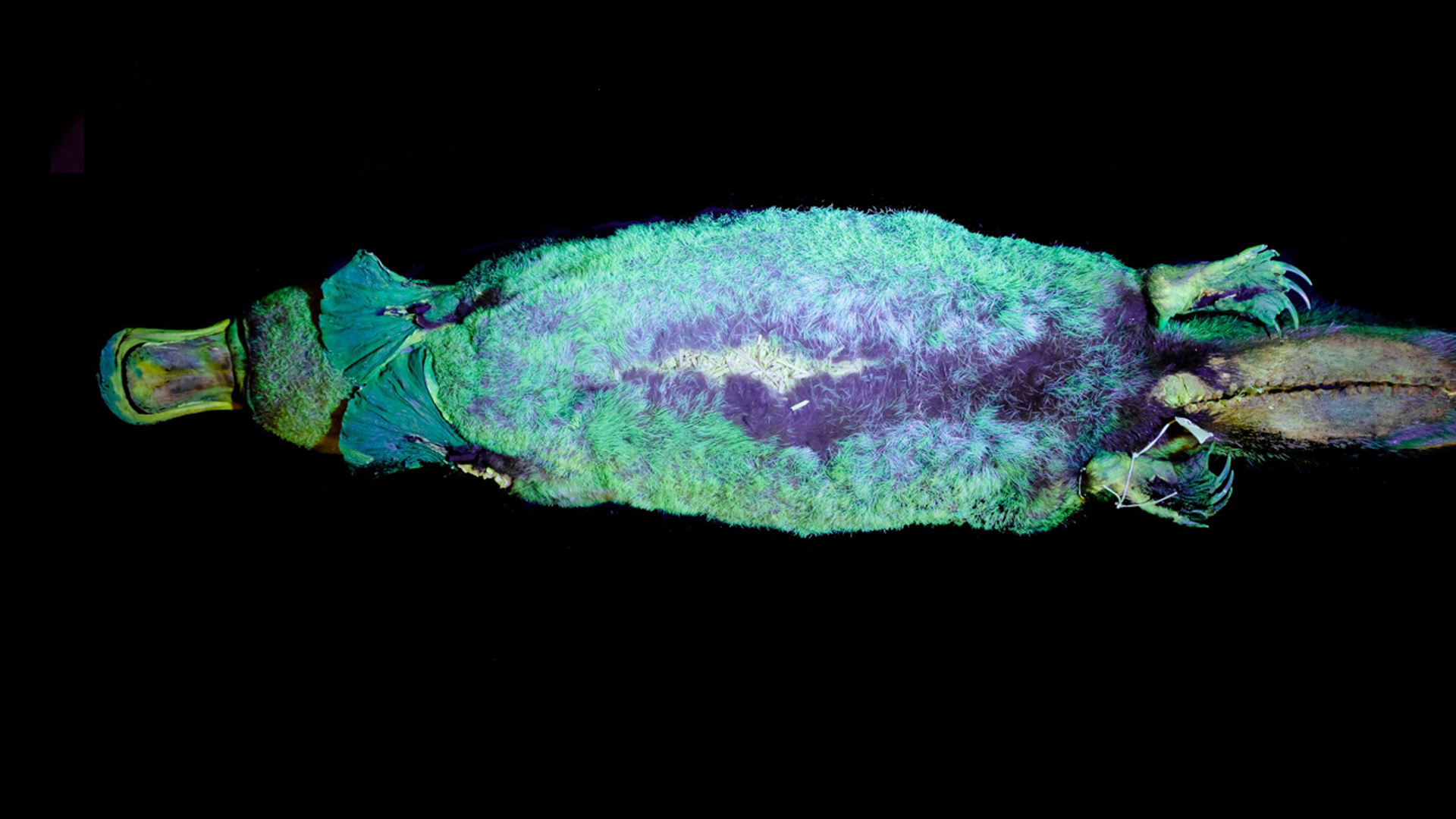
Venom
Male platypuses deport venom glands, located near their pelvises, that connect to hollow spurs on their hind legs, according to a web log written by Bianca op den Brouw, a toxinologist at the Academy of Melbourne in Commonwealth of australia. Young females also have these spurs, only they lose them in the start year of life.
The venom glands of adult males fluctuate in size throughout the yr, reaching their maximum size during breeding season, when males use their venom to compete for mates. To inject its venom, a male person wraps its legs around its victim and drives the spurs through the animal'southward flesh, co-ordinate to op den Brouw.
The venom itself contains a cocktail of more than than a dozen proteins that belong to three major classes of toxins, op den Brouw wrote. This venom is not lethal to platypuses or humans, but information technology causes swelling and excruciating pain, and information technology can disrupt wound healing and the function of prison cell membranes, she noted. In humans, the hurting from a platypus sting can be treated with nerve blockers, which block specific nervus cells from sending signals to the encephalon.
Habitat
Platypuses live in Commonwealth of australia in a range that extends from western Victoria to about as far north as Cooktown in Queensland, meaning they occupy a large stretch of the east and southeast coast of the country, according to the Australian Platypus Conservatory. The creatures can also be found on Tasmania and King Isle, as well as on Kangaroo Island, where platypuses were introduced past humans in the early on 1900s.
Platypuses occupy freshwater systems — including river basins, lakes, ponds and streams — throughout their habitat range. The animals spend about 10 to 12 hours a night in the water, hunting for food; they are nigh active during dark and dusk, considering they are nocturnal. They tin stay underwater for merely 30 to 140 seconds, the Australian Museum notes.
During the day, they hide out in burrows on the shore, where earthen tunnels open up upwardly into oval-shaped hugger-mugger chambers, according to the San Diego Zoo. Platypuses also accept shelter under rock ledges, roots and debris, according to the Australian Platypus Conservatory.
Though they exist on only one side of one continent, platypuses weather many climatic extremes. They have been establish in plateaus, lowlands, tropical rainforests, and the cold mountains of Tasmania and the Australian Alps. Platypuses' waterproof, thick fur keeps them warm in dank weather, and their big tails store extra fat for energy, co-ordinate to the Australian Platypus Conservatory.
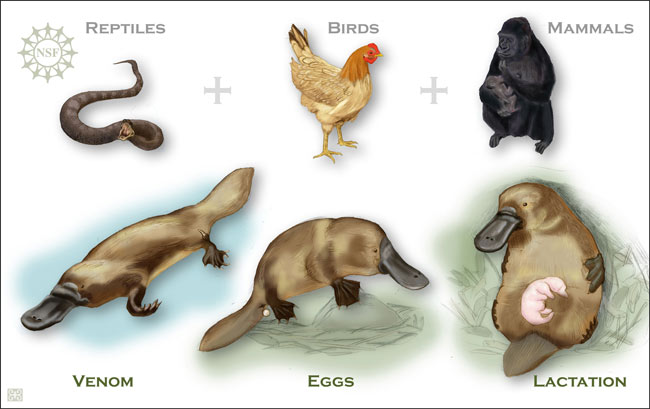
Diet
Platypuses are cannibal, which means they eat meat just not plants. They hunt for their nutrient in the water where they alive. As they swim, they discover nutrient forth the dingy lesser of the river, stream, pond or lake using only their sensitive bills, since the animals actually shut their eyes, ears and nostrils while foraging underwater, according to the Australian Museum.
When platypuses notice something interesting, like insect larvae, they scoop it up in their bills, store it in their cheek pouches and swim to the surface. The animals also eat shrimp, pond beetles, water bugs and tadpoles, as well every bit the occasional worm, freshwater pea mussel or snail. Platypuses have even been observed eating cicadas and moths that they catch at the water's surface, co-ordinate to the Australian Museum.
Subsequently coming upwards from a swoop, platypuses float atop the water and chew their food using "grinding plates" in their mouths. The animals sometimes selection up mud and sand in their cheek pouches, and equally they eat, they expel this inedible sediment, forth with backlog h2o, through grooves in their lower jaws, according to the Australian Platypus Solarium.
Baby platypuses
Most mammals give birth to live young. Platypuses, nevertheless, lay eggs. Mammals that lay eggs are known as monotremes, and besides the platypus, the merely other monotremes are echidnas, or spiny anteaters, according to the University of Melbourne. Echidnas are found only in Australia and New Guinea.
When female platypuses are prepare to accept their immature, they burrow inside the ground on the riverbank and seal themselves into tunnel rooms. Each female person then lays ane to iii eggs and places them between her rump and her tail to keep them warm. After about x days, the eggs hatch and the bean-size babies nurse for three to iv months inside their burrow, according to the Australian Museum.
Around the time of weaning, baby platypuses can swim on their ain, co-ordinate to the Australian Platypus Conservatory.
Taxonomy
Here is the taxonomy of the platypus, co-ordinate to the Integrated Taxonomic Information System (ITIS):
- Kingdom: Animalia
- Phylum: Chordata
- Class: Mammalia
- Lodge: Monotremata
- Family: Ornithorhynchidae
- Genus and species: Ornithorhynchus anatinus
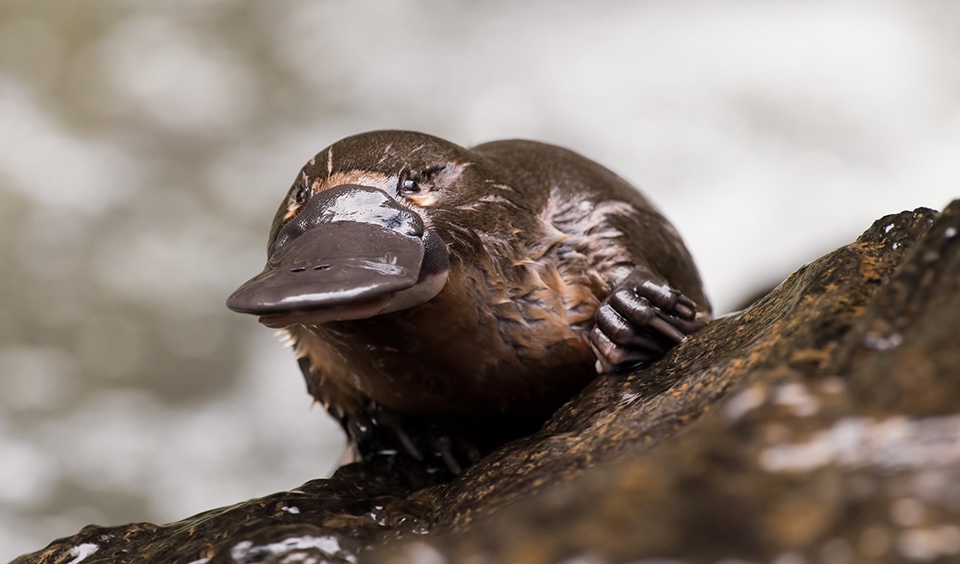
Conservation status
Platypuses are not endangered, but the International Matrimony for Conservation of Nature (IUCN) lists them as "near threatened," meaning the species may be vulnerable to extinction in the nigh future but does not currently qualify as threatened.
The platypus was kickoff listed as virtually threatened in 2016 afterwards scientists observed a refuse in the species' overall numbers, "although the turn down is poorly defined and inconsistent beyond the platypus'south range," the Australian Platypus Conservatory notes on its website.
Additional resources and readings
- Scout this video nigh how scientists discovered that platypuses glow nether UV light, from SciShow .
- Explore the scientific contend over whether platypuses were real animals, in the book "Platypus: The Extraordinary Story of How a Curious Animate being Baffled the World" (Smithsonian Books, 2001), past Ann Moyal.
- Learn virtually platypuses' weird genetic quirks, via NPR.
Bibliography
Australian Platypus Conservancy. (n.d). Platypus biological science. Australian Platypus Conservancy. Retrieved February xi, 2022, from https://platypus.asn.au/biology/
Australian Platypus Conservancy. (n.d.). Distribution & numbers. Australian Platypus Conservancy. Retrieved February 11, 2022, from https://platypus.asn.au/distribution-numbers/
Divljan, A. D. A. (2021, June sixteen). Platypus. The Australian Museum. Retrieved February eleven, 2022, from https://australian.museum/learn/animals/mammals/platypus/
Fish, F. Eastward., Frappell, P. B., Baudinette, R. V., & MacFarlane, P. M. (2001). Energetics of terrestrial locomotion of the platypus Ornithorhynchus anatinus. Journal of Experimental Biology, 204(4), 797–803. https://doi.org/10.1242/jeb.204.four.797
Integrated Taxonomic Information System (ITIS). (due north.d.). Ornithorhynchus anatinus (Shaw, 1799). Integrated Taxonomic Information System. Retrieved February 11, 2022, from https://www.itis.gov/servlet/SingleRpt/SingleRpt?search_topic=TSN&search_value=552524#null
International Union for Conservation of Nature. (n.d.). Platypus. IUCN Cherry-red List of Threatened Species. Retrieved February 11, 2022, from https://world wide web.iucnredlist.org/species/40488/21964009
National Geographic. (n.d.). Platypus. National Geographic. Retrieved February 18, 2022, from https://www.nationalgeographic.com/animals/mammals/facts/platypus
op den Brouw, B. (2020, July 17). Wide world of venom - the platypus. The University of Melbourne, School of Biomedical Sciences. Retrieved February xi, 2022, from https://biomedicalsciences.unimelb.edu.au/departments/section-of-biochemistry-and-pharmacology/engage/avru/blog/broad-earth-of-venom-the-platypus
Osterloff, East. (2018). The platypus puzzle. Natural History Museum. Retrieved Feb eleven, 2022, from https://www.nhm.air-conditioning.united kingdom of great britain and northern ireland/detect/the-platypus-puzzle.html
San Diego Zoo. (n.d.). Platypus. San Diego Zoo Wild fauna Explorers. Retrieved Feb 11, 2022, from https://sdzwildlifeexplorers.org/animals/platypus
This article was last updated on Feb. 18, 2022, by Alive Science staff writer Nicoletta Lanese.
Originally published on Alive Scientific discipline.
smallwoodfixecition.blogspot.com
Source: https://www.livescience.com/27572-platypus.html
Post a Comment for "Everything You Need to Know About Platerpus"